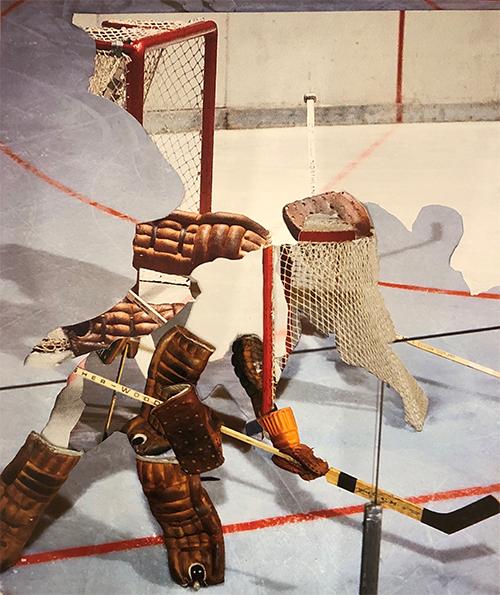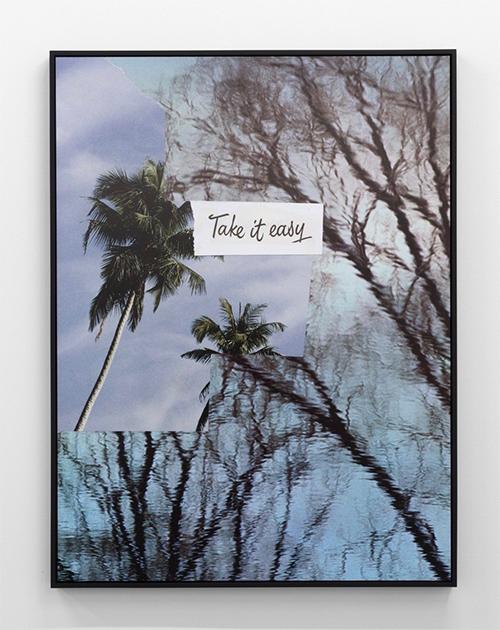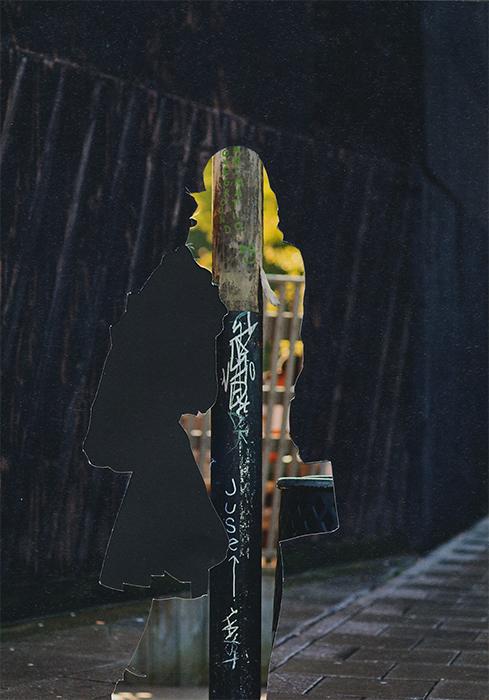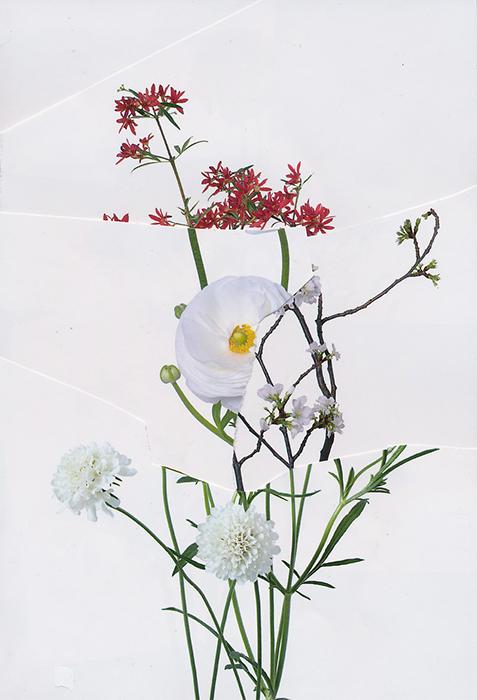DIPLOMA IN FINE ARTS, 1997
Maguire: Can you talk about your artistic practice? How has it evolved since you graduated from ACAD?
Butler: As I was about to graduate from ACAD, I started doing these collage parties. It wasn’t a conscious decision; I wasn’t thinking, “…this is historically grounded in Happenings, this is my art form, this is how I am going to make my mark in the art world” or anything like that. As an artist, I really missed having people around because we had a really social drawing department at ACAD. So I started to invite people over. I was doing collage at the time and I just left all my materials out for my guests to use.
The first collage party I had was just a party. Instead of playing darts or pool or anything like that, we made collage. The next day everyone referred to it as the “collage party” so in that way it had kind of taken its own form without me consciously doing anything.
I was put into a show in the Winnipeg Gallery called Draw Stranger (curated by Wayne Baerwaldt), which was ironic for me because I was a drawing major but felt like I almost abandoned drawing and went to collage, even though I’d been doing collage my whole life. A lot of people think of collage more like a sketch toward something greater. My first break was a show about different ways of drawing, any cutting of lines and using tape was mark-making, or drawing. I came around full circle really quick: I was back at drawing!
I kept doing these collage parties because I enjoyed them. I was invited to Goldsmith’s College in London so I went to the Manitoba Arts Council and kind of sheepishly asked if this was something they would support, if I could get money from the Council for travel. My advisor at the time told me “Paul, of course. This is your art! This is your practice. This is a legitimate art form.” I feel like I’m always the last one to know what I’m doing [laughs].
So that was the beginning of the collage party, and I continue to host them. I had one last night in my studio, with the filmmaker Guy Maddin and lots of other local filmmakers and writers. It’s been my studio practice ever since. I really carried over the energy of the art school over into my studio practice. I sometimes joke that it’s these great lengths that I go to for selfish reasons - in order to make my own individual work, I gather all these people around me so I can feed off their energy and ideas.

untitled (from Hockey series), Collage, 9 x 12 in, 2018. Image courtesy of Paul Butler.
Maguire: What advice or insight do you have about making a living as an artist?
Butler: I’ve always been almost obsessed with making a living off art without compromising too much. In 2001, four years after I graduated, I opened up a commercial art gallery called The Other Gallery, because there were so many great artists in Winnipeg. I worked with Karel Funk, and the Royal Art Lodge, Sarah Anne Jonhson, and lots of other artists. A lot of them got their start with my gallery, which had a physical space in Winnipeg for about a year. Quite quickly, anyone who bought art in Winnipeg had exhausted their budget. Galleries in California, particularly, were using my website to find new artists because Winnipeg had an international reputation already. I was getting cut out of the deal, because I was an artist myself and would never stand in the way of someone’s opportunity.
At that point I thought these people from abroad were never going to come to Winnipeg to buy art. Alternative art fairs were just starting. I decided to turn The Other Gallery into a nomadic model, rather than a physical space here in Winnipeg. People would never know because they would never come to Winnipeg to find out for themselves, and I would do these art fairs in Miami, New York, London, L.A. I did that for 10 years, while maintaining my own practice and keeping up with The Collage Parties.
In the beginning of my career, people always told me I had to choose between one or the other – running a gallery or having a studio practice. Years later those same people celebrated that I was able to manage both. Some people started to see me as a curator. Fast forward to about three years ago, I was going through one of my cycles where I was questioning how I was going to make my practice work financially. I was putting in my 80 hours a week, but it is so inconsistent and unstable making money as an artist. I thought then that I would go get my Master’s and my certification to teach. I went back to Concordia, in Montreal, and after a year I started up this conversation with the Winnipeg Art Gallery. To my surprise, they asked me to be their curator of contemporary art. I just had to try it and take that chance.
Since then, I’ve spent the past year wondering how the hell I ended up back in Winnipeg, being kind of depressed [laughs]. I decided art is the answer, I needed to get active making art. It’s kind of my religion. I just need to make art, and when I am not making art I am not happy, and when I am making art I am happy. I am almost back in a full circle again, doing what I enjoy. I’ve finally separated doing what I feel like I should do or what’s expected of me from what I want to do. It’s making a big difference for me.

Take It Easy, C-Print on Aluminium, 30” x 40”, 2018. Image courtesy of Paul Butler.
You see these statistics of people who get jobs out of fine arts programs, but you want to ask who is a full time fine artist and who is a graphic designer? When I went to school, the people I graduated with felt like it was sink or swim once you were done with school. ACAD tries to cover making a living, but there’s not nearly enough time to go over everything.
It seems kind of obvious, but you have to hustle and make yourself available. The school provides access to all kinds of people and ideas, but you have to know what you want, and know what to ask for. Nobody can tell you what you want except you. No one can teach you how to be talented. Schools should not only help students find their artistic voices but give them the survival tools to turn their talent into a way to make a living.
There should be a distinction between commercial artists, museum artists… I went through my whole time at ACAD thinking that my only option was to be a big art star. I saw the frustration of some of my peers who went into more administrative roles: those choices didn’t seem to be presented at the beginning. That there were more options than just showing at a museum or contemporary art gallery.
There’s a massive spectrum of areas that people can go into with a fine arts degree. The sooner you can identify that, the sooner you can start your journey. No student in my first few years said, “I want to become a curator!” We were all trying to become artists in the simplest sense.
Maguire: It seems like even between being an artist and a curator, choosing within or between those disciplines can be difficult.
Butler: Definitely. For myself, I wanted to understand how the whole art machine works. The whole art world. I’ve been on boards for The Power Plant and The Plug In, I’ve organized alternative schools, I’ve organized a residency at the Banff Centre called Reverse Pedagogy where all the participants were equal, and we collectively directed the residency. Justin Waddell, who I believe teaches at ACAD, was a participant. We were lucky to put together a great cast of all star artists for that residency.
I’ve also organized a painting competition for Nuit Blanche at the AGO (Art Gallery of Ontario), so I got into art competitions. I’ve been a curator in an institution, I’ve run a commercial gallery, directed an art fair, taught and all the while I have maintained my collage practice.
I see it all as my art practice. All of my branches of work have been under the art world umbrella. If I am going to have to work a job to supplement my income, why does it make sense to be serving at a restaurant rather than working at an art gallery? I lose all of those contacts and that exposure, and the opportunity to learn more about what I care about.
Ultimately, looking back, I have built up an international network from running galleries and facilitating collage parties. All of the fruit that I have picked from those branches have come back to support my practice. That’s a great education that I have created for myself; I know the curatorial world, the commercial world. I know all the ins and outs of the people I will have to work with as an artist. They really appreciate it, I know; when I work with a curator I know what their needs and concerns are. I am really easy to work with. Before I wondered why on earth a commercial gallery gets 50% of a sale [of an artist’s work], and now it makes sense after having run a gallery.

Untitled (from what's within series), Collage, 5" x 7", 2015. Image courtesy of Paul Butler.
Maguire: Do you have any specific advice that you would give to a student when it comes to making the most of their time at ACAD?
Butler: You have to make what you want out of it. A school is this hub where all of these people come together and you get exposed to different ways of working, different ideas. It’s all available to you, but it’s up to you to make something out of it and connect with people and teachers who will turn you on to new things. It’s a concentrated art community: you get to try all sorts of things, pick and choose what you do.
The other really important thing about school is letting yourself fail. For example, I did a collage party at ACAD. The collage parties that I have put on work 99% of the time, it just amazes me. People are drawn to it like fish to water. But when I did the one at ACAD people weren’t really coming. A few first year students were coming, but the fourth year students weren’t participating at all. It seemed weird.
Finally, on the last day, one of the fourth year students came to me and felt like they should explain what was going on. He said, “the fourth year students aren’t coming because they don’t want to be associated with first year work, because they are concerned about their resumes.” Oh man! All I could think was, “well, they are missing out!” [Art school] is the safe place for you to experiment, make mistakes, without thinking about your CV yet. If in an art school you are worried about those issues, and not allowing yourself to be free enough to have fun, then somebody is doing something wrong.
The chance to fail is really important. I’ve been watching The Voice this season [laughs] but you can see how some people grow on that show. They push themselves out of their comfort zones, and it’s to their benefit at the end. It helps you define what it is you want to be by experiencing all the things you don’t want to be.
Mentorship is great, and important. There’s all these ACAD alumni out in the world that aren’t necessarily teaching that are amazing artists. Even us having this one phone conversation, even if it’s not published or shared with anybody, you are getting access to hands-on experience. Art school is great, but you have to have that appetite to grow, and to articulate what you want to be and how you want to push yourself. There’s no reason to think that when you leave you are done learning and have to close all the doors to personal growth. I guess we’re talking about life, now, too.

untitled (from Flower series), Collage, 5" x 7", 2019. Image courtesy of Paul Butler.
Maguire: Are there any specific obstacles that you encountered after graduation?
Butler: An obstacle can be yourself. If you don’t know exactly what it is you want to accomplish, if you can’t articulate who your audience is…
For example, I was talking to a recent graduate here in Winnipeg. They wanted to sell their work, but they admitted that they would choose the more challenging works that they had made to exhibit for sale, and not the ones they felt people would be drawn to more easily. The artist wanted to prove a point, or something. I said, “If you’ve already decided you want to be a commercial artist, you have an obligation to your buyer. That buyer may be a specific clientele, but why would you want to treat them that way? To prove them wrong, or force them to like something? It’s a commercial exchange. You want to supply them with what they want.”
I’m not at all saying that that is the route that everyone should take. But, if you have decided that that is what you want to do, then be that person. Of course you can also go the route of installation art, being a museum artist, or making more challenging things. If you want to be in museum collections, it’s worth your while to do some research on what they collect. It will save you so much frustration.
So yeah, that’s a big obstacle. Getting out of your own way. Figuring out what you want to be, accepting it, and then pursuing it. I hear all the time from people who are frustrated because they are not being accepted in one part of the art world, when all of their actions and the way they put themselves out there shows that they are an entirely different kind of artist. You can be your worst obstacle.

untitled (from Flower series), Collage, 5" x 7", 2019. Image courtesy of Paul Butler
Maguire: Where does ACAD and our alumni fit into our cultural and economic prosperity, especially in the current financial climate?
Butler: I think that ACAD should focus on one or the other, namely cultural prosperity. ACAD should help people articulate their voices as artists, figure out what they want to do, who their audience is, what the message is, and how the artist is going to contribute to society, in a sense. Then, you can figure out how to make it work financially, once you figure out what those goals are. You kind of have to leave the economic part out of it. For me, I’ll say it again, the most important part is finding your voice and finding how you can contribute. I think that is a big role of art. Then, after, you figure out how to make it work financially. If you’re trying to figure out how to make both sides, cultural and economic, work from the get go, it’s really difficult to navigate.
There’s the kind of artist who figures it out like they’re on Survivor or a reality show; they go out, analyze the world, and make what that world wants to see. Then there’s the other kind who makes what they need to make, what they want to make, and if there’s an audience for it, great, but that’s not their focus. Selling it comes after that. I think that’s how we should work.
It’s the school and gallery’s job to clarify the currency and value of culture. ACAD’s value is not a monetary one.
